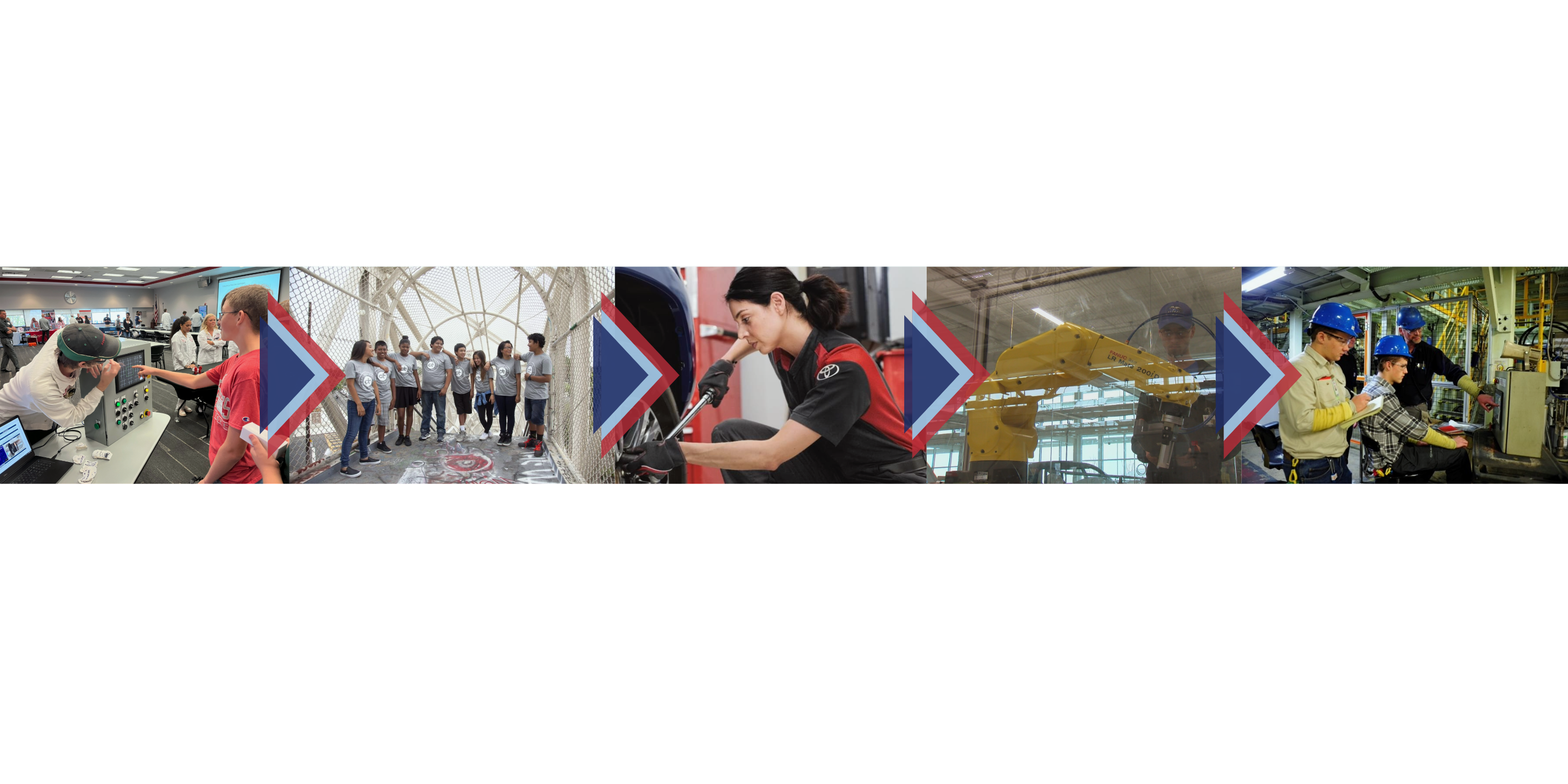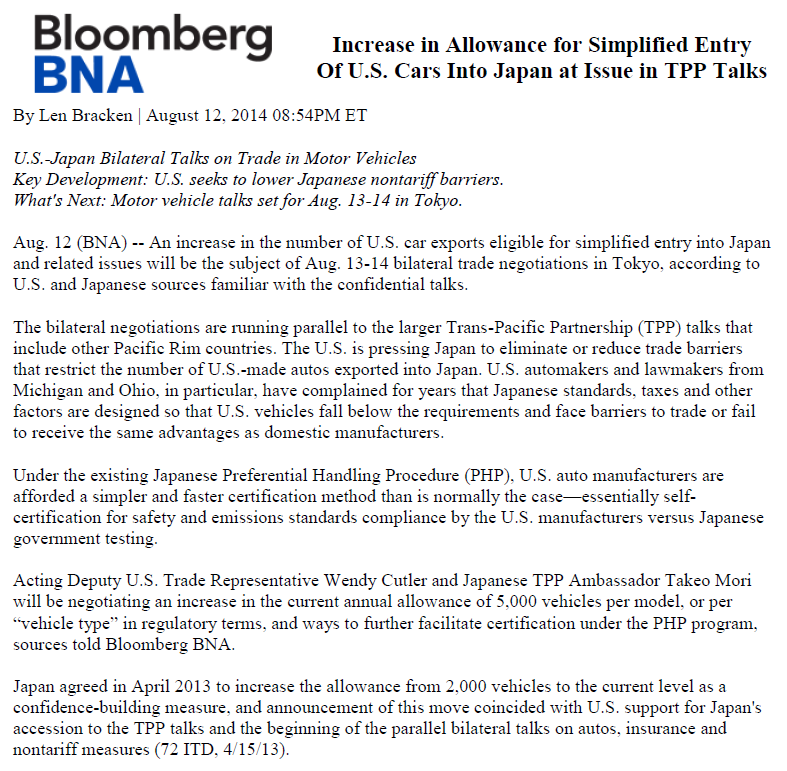Reproduced with permission from Daily Report for Executives, 156 DER A-29 (Aug. 13, 2014). Copyright 2014 by The Bureau of National Affairs, Inc. (800-372-1033) <http://www.bna.com>
By Len Bracken
August 12, 2014
U.S.-Japan Bilateral Talks on Trade in Motor Vehicles Key Development: U.S. seeks to lower Japanese nontariff barriers.
What’s Next: Motor vehicle talks set for Aug. 13-14 in Tokyo.
Aug. 12 (BNA) — An increase in the number of U.S. car exports eligible for simplified entry into Japan and related issues will be the subject of Aug. 13-14 bilateral trade negotiations in Tokyo, according to U.S. and Japanese sources familiar with the confidential talks.
The bilateral negotiations are running parallel to the larger Trans-Pacific Partnership (TPP) talks that include other Pacific Rim countries. The U.S. is pressing Japan to eliminate or reduce trade barriers that restrict the number of U.S.-made autos exported into Japan. U.S. automakers and lawmakers from Michigan and Ohio, in particular, have complained for years that Japanese standards, taxes and other factors are designed so that U.S. vehicles fall below the requirements and face barriers to trade or fail to receive the same advantages as domestic manufacturers.
Under the existing Japanese Preferential Handling Procedure (PHP), U.S. auto manufacturers are afforded a simpler and faster certification method than is normally the case—essentially self-certification for safety and emissions standards compliance by the U.S. manufacturers versus Japanese government testing.
Acting Deputy U.S. Trade Representative Wendy Cutler and Japanese TPP Ambassador Takeo Mori will be negotiating an increase in the current annual allowance of 5,000 vehicles per model, or per “vehicle type” in regulatory terms, and ways to further facilitate certification under the PHP program, sources told Bloomberg BNA.
Japan agreed in April 2013 to increase the allowance from 2,000 vehicles to the current level as a confidence-building measure, and announcement of this move coincided with U.S. support for Japan’s accession to the TPP talks and the beginning of the parallel bilateral talks on autos, insurance and nontariff measures (72 ITD, 4/15/13).
Although the PHP allowance may be increased as a result of the talks, industry analysts told Bloomberg BNA that U.S. manufacturers export far fewer than 5,000 vehicles per vehicle type, adding that in 2013 the U.S. manufacturers exported 25 models to Japan compared with 260 models by EU manufacturers.
The U.S. automakers could export more models, the analysts said, but choose not to, noting that U.S. dealerships have decreased by 74 percent from 1996 to 2013 while European dealerships have increased 72 percent during the same period. The analysts point to these divergences in the number of models and dealerships as well as the amount spent on advertising as accounting for the slow decline in U.S. automakers’ market share in Japan and the steady increase in market share by EU automakers.
‘Eco Car’ Tax Credit
The two sides also will discuss whether Japanese tax breaks for low emission and energy efficient vehicles, known as the “eco car” tax credit and similar to the U.S. “cash for clunkers” program, should be extended to U.S. vehicles imported under the PHP program.
The Terms of Reference text that has served the basis for the bilateral negotiations on motor vehicle trade since the outset of the bilateral talks states that the negotiators will seek “to ensure that such measures do not have the effect of discriminating against U.S. motor vehicles including those imported under the PHP program.”
While U.S. automakers have benefited from the reduction in paperwork and other simplifications associated with the PHP program, the exemption from energy efficiency and emission testing in Japan has effectively excluded U.S. vehicles in the PHP program from the Japanese “eco car” tax incentive program.
Sources told Bloomberg BNA that U.S. vehicles do not meet the current requirements for these financial incentives, and U.S. negotiators want Japan to alter the program to allow more U.S. imports to be eligible for such credits.
Japanese negotiators could argue that auto manufacturers based in the European Union have been able to adjust to Japan’s tax system and meet the fuel efficiency and emission requirements, the sources said. They questioned whether the U.S. could be given special terms under TPP as this would be at odds with the most-favored-nation principle common to trade agreements whereby the most favorable terms given to one country are extended to all parties to an agreement.
Distribution, Standards
U.S. industry representatives have told Bloomberg BNA that they view the “eco car” tax incentives as excluding cars participating in the PHP program. They also said that while domestic dealer networks might technically be allowed to sell foreign-made cars, in practice this is not allowed. Other industry sources said that Toyota dealerships in Japan sell Volkswagen and Nissan dealers sell Renault vehicles.
In general, the U.S. industry sources said, Japanese standards, taxes and other factors are designed so that U.S. vehicles fall below the requirements and face barriers to trade or fail to receive the same advantages as domestic manufacturers. These sources would like to see fewer cars being required to go through standards certification if most are passing the required tests.
While Japan does not have tariffs on auto imports, the U.S. has a 25 percent tariff on Japanese light trucks and a 2.5 percent tariff on Japanese passenger cars. The two sides agreed at the outset of the talks in April 2013 that the U.S. tariffs would be phased out in accordance with the longest staging period for any other product in the TPP negotiations, and that the bulk of the phaseouts would take place at the end of the staging period.
The results of the bilateral negotiations on motor vehicles will be included as enforceable commitments in the final bilateral market access package agreed to between the U.S. and Japan in the TPP negotiation.
The other 10 TPP partners are Australia, Brunei, Canada, Chile, Malaysia, Mexico, New Zealand, Peru, Singapore and Vietnam.
Click to view PDF:


